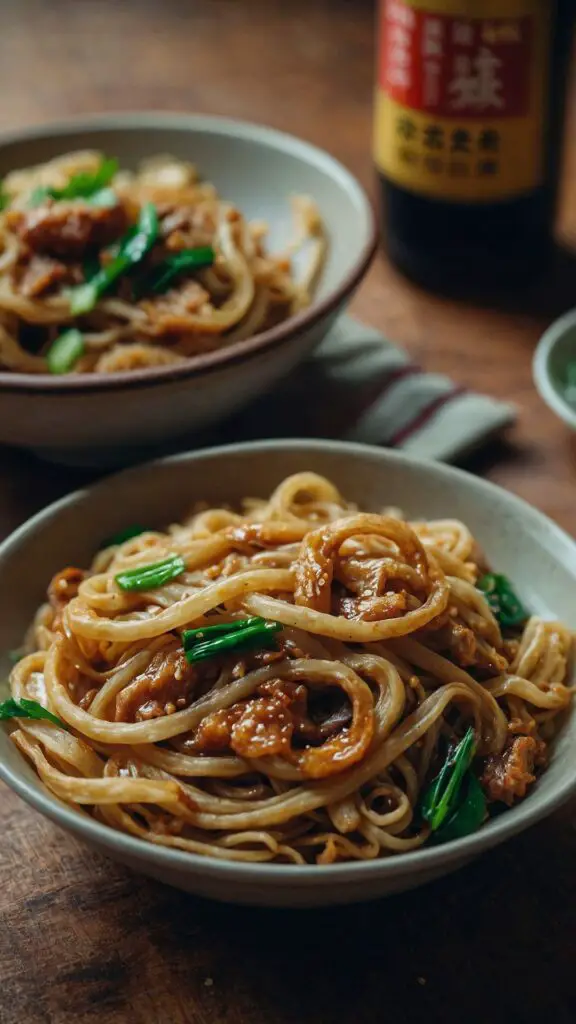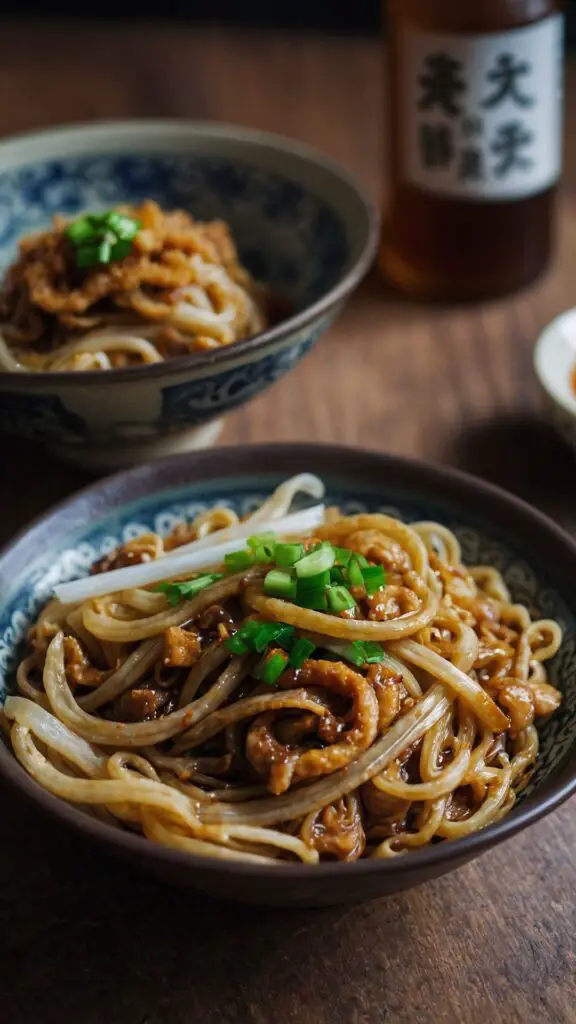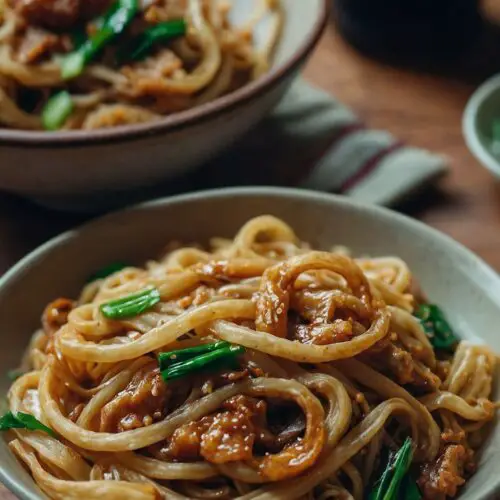Shanghai Fried Noodles – Culinary Chase
When diving into the delicious world of Shanghai fried noodles, it’s essential to think about what will complement this dish perfectly. Consider pairing these savory noodles with a light, refreshing cucumber salad dressed in sesame oil. The cool crunch of the cucumbers will provide a beautiful contrast to the rich, savory flavors of the noodles.
Alternatively, you might enjoy some crispy spring rolls or dumplings on the side. Their various fillings and textures will enhance the overall meal experience. For those who appreciate a bit of heat, a spicy chili oil can be served as a dipping sauce. This combination will take your dining experience to a whole new level!

I vividly remember my first encounter with Shanghai fried noodles. It was in a bustling little restaurant tucked away in an alley in Shanghai. The aroma wafting from the kitchen captivated me. One bite led to another, and I was hooked. The beauty of this dish lies in its harmony of flavors and textures.
As I delved deeper into the realm of culinary exploration, I realized just how unique Shanghai fried noodles are. They are not merely a plate of noodles; they carry a story, a tradition, and a delightful punch of flavor that keeps you coming back for more!
What is Shanghai Fried Noodles?
Shanghai fried noodles, also known as “Chao Mian,” have their roots deeply embedded in the vibrant streets of Shanghai. Unlike their counterparts found in other regions, these noodles are typically thicker, lending a satisfying chewiness to every bite. They are stir-fried with a variety of fresh vegetables and meats, often featuring pork or shrimp, and are seasoned with soy sauce, ginger, and garlic.
The dish is both a staple in Chinese households and a favorite in restaurants. It brings together the simplicity of stir-frying with the rich flavors of Chinese cooking. It’s filling enough to be a main course yet versatile enough to accompany a multitude of dishes.
What is the Flavor Profile of This Dish?
The flavor profile of Shanghai fried noodles is a delightful balance. The umami from soy sauce intertwines beautifully with the sweetness of the vegetables and the savory depth of the protein. A hint of garlic adds an aromatic warmth, while ginger offers a refreshing bite to cut through the richness. The noodles themselves carry a subtle nuttiness, especially when cooked to perfection.
Texture plays an equally important role here. The soft, chewy noodles combined with crisp vegetables create a satisfying mouthfeel. Each ingredient contributes to a delightful explosion of flavors and textures with every single bite.
You will also like the following Lunch and Dinner recipes!
What Makes This Recipe Different From Other Shanghai Fried Noodles?
You might wonder how this recipe stands out among the plethora of Shanghai fried noodle variations. Here are a couple of points:
1. Quality of Noodles: I always opt for high-quality Japanese-style udon noodles. Their thickness and chewiness elevate the dish, setting it apart from standard thin noodles.
2. Balanced Ingredients: While many recipes tend to overload on soy sauce, I add just enough to enhance the flavors without overwhelming the other ingredients. This approach gives the dish depth without masking subtle flavors.
3. Fresh Seasoning: The incorporation of freshly grated ginger and garlic makes a noticeable difference. These fresh elements brighten the overall taste, ensuring each bite is a burst of freshness.
Ingredients You’ll Need
Before we dive into the cooking process, let’s gather our ingredients. Here’s what you’ll need:
For the Pork & Marinade (omit for vegetarian option):
- 6 ounces boneless pork (shoulder, butt, or loin, thinly sliced into strips)
- 1/4 teaspoon freshly grated ginger
- 1/8 teaspoon granulated sugar
- 1 teaspoon Shaoxing rice wine (or dry cooking sherry)
- 3/4 teaspoon cornstarch
- 1/2 teaspoon light soy sauce
- 1/8 teaspoon dark soy sauce
For the Rest of the Dish:
- 1 small garlic clove, minced
- 8 shiitake mushrooms (fresh or rehydrated dried, thinly sliced)
- 3 tablespoons neutral oil (vegetable, canola, or avocado oil, divided)
- 1 pound Japanese-style udon noodles
- 2 1/2 teaspoons dark soy sauce
- 2 1/2 teaspoons light soy sauce
- 1/4 teaspoon brown sugar (replaces regular sugar for a deeper sweetness)
- 1 bunch choy sum or baby bok choy

Step by Step Directions
Step 1: Marinate the Pork
In a bowl, combine the pork slices with ginger, sugar, Shaoxing rice wine, cornstarch, light soy sauce, and dark soy sauce. Mix well and set aside for about 15 minutes. This marinating process infuses the pork with flavor and tenderizes it.
Step 2: Prepare the Noodles
While the pork is marinating, cook the udon noodles according to the package instructions. Drain and rinse under cold water to stop the cooking process. Set aside. The cold water will keep the noodles from becoming gummy.
Step 3: Stir-Fry the Pork
Heat one tablespoon of neutral oil in a wok or large skillet over medium-high heat. Once hot, add the marinated pork in a single layer. Sauté until lightly browned and cooked through, about 3 to 5 minutes. Remove the pork and set it aside.
Step 4: Sauté the Vegetables
In the same skillet, add another tablespoon of oil. Toss in the minced garlic and sauté for about 30 seconds until fragrant. Add the shiitake mushrooms and cook until tender, roughly 2 minutes.
Step 5: Combine Everything
Return the pork to the wok, followed by the cooked udon noodles. Pour in the dark and light soy sauces and add brown sugar. Toss everything together gently, ensuring that all the ingredients are well mixed and the noodles are heated through.
Step 6: Add the Greens
Finally, toss in the choy sum or baby bok choy. Stir-fry for an additional 1 to 2 minutes until the greens are wilted but still vibrant. The bright green vegetables add not just color but also nutrients to the dish.
Step 7: Serve and Enjoy!
Serve your Shanghai fried noodles hot. Feel free to garnish with sliced green onions or sesame seeds for an extra touch.
Tips on Making Shanghai Fried Noodles
- Choose the Right Noodles: Stick to udon or similar thick noodles for that perfect chewiness.
- Do Not Overcrowd the Pan: Cooking in batches prevents the pork from steaming and ensures it gets a nice sear.
- Prep Ingredients Ahead: Chop and prepare all ingredients before you start. Stir-frying goes quickly, and you’ll want everything at hand.
- Heat Control: Maintain medium-high heat to achieve a good stir-fry. Too low, and the ingredients steam instead of crisping up.
- Customize the Veggies: Feel free to swap in other vegetables you love, like bell peppers or carrots. Just ensure the textures are similar to keep the dish balanced.
Nutrition Information
Per serving (estimate):
- Calories: 450
- Protein: 30g
- Carbohydrates: 50g
- Fat: 15g
- Fiber: 3g
These figures can vary based on specific ingredients used.
How Can I Store This Shanghai Fried Noodles?
If you have leftovers (if they last that long!), cool them to room temperature and transfer them to an airtight container. They can be stored in the fridge for up to 3 days. Reheat on the stovetop with a splash of water to revive the noodles’ texture.

If the Items Are Not Available in Your Kitchen, What Are Some Substitute Options for the Ingredients?
- Pork: If you cannot find pork, chicken or beef works beautifully. Just adjust the cooking time depending on the thickness of the meat.
- Udon Noodles: If udon noodles are not accessible, lo mein or rice noodles can provide a satisfying alternative.
- Choy Sum or Baby Bok Choy: In the absence of these greens, spinach or kale can make for a great substitute. They cook quickly and will wilt nicely in the stir-fry.
- Shaoxing Rice Wine: If you lack this, feel free to use dry sherry or white wine to achieve a similar depth of flavor.

Shanghai Fried Noodles
Equipment
- Skillet
- Bowl
Ingredients
For the Pork & Marinade (omit for vegetarian option):
- 6 ounces boneless pork shoulder, butt, or loin, thinly sliced into strips
- 1/4 teaspoon freshly grated ginger
- 1/8 teaspoon granulated sugar
- 1 teaspoon Shaoxing rice wine or dry cooking sherry
- 3/4 teaspoon cornstarch
- 1/2 teaspoon light soy sauce
- 1/8 teaspoon dark soy sauce
For the Rest of the Dish:
- 1 small garlic clove minced
- 8 shiitake mushrooms fresh or rehydrated dried, thinly sliced
- 3 tablespoons neutral oil vegetable, canola, or avocado oil, divided
- 1 pound Japanese-style udon noodles
- 2 1/2 teaspoons dark soy sauce
- 2 1/2 teaspoons light soy sauce
- 1/4 teaspoon brown sugar replaces regular sugar for a deeper sweetness
- 1 bunch choy sum or baby bok choy
Instructions
Step 1: Marinate the Pork
- In a bowl, combine the pork slices with ginger, sugar, Shaoxing rice wine, cornstarch, light soy sauce, and dark soy sauce. Mix well and set aside for about 15 minutes. This marinating process infuses the pork with flavor and tenderizes it.
Step 2: Prepare the Noodles
- While the pork is marinating, cook the udon noodles according to the package instructions. Drain and rinse under cold water to stop the cooking process. Set aside. The cold water will keep the noodles from becoming gummy.
Step 3: Stir-Fry the Pork
- Heat one tablespoon of neutral oil in a wok or large skillet over medium-high heat. Once hot, add the marinated pork in a single layer. Sauté until lightly browned and cooked through, about 3 to 5 minutes. Remove the pork and set it aside.
Step 4: Sauté the Vegetables
- In the same skillet, add another tablespoon of oil. Toss in the minced garlic and sauté for about 30 seconds until fragrant. Add the shiitake mushrooms and cook until tender, roughly 2 minutes.
Step 5: Combine Everything
- Return the pork to the wok, followed by the cooked udon noodles. Pour in the dark and light soy sauces and add brown sugar. Toss everything together gently, ensuring that all the ingredients are well mixed and the noodles are heated through.
Step 6: Add the Greens
- Finally, toss in the choy sum or baby bok choy. Stir-fry for an additional 1 to 2 minutes until the greens are wilted but still vibrant. The bright green vegetables add not just color but also nutrients to the dish.
Step 7: Serve and Enjoy!
- Serve your Shanghai fried noodles hot. Feel free to garnish with sliced green onions or sesame seeds for an extra touch.
Notes
- Choose the Right Noodles: Stick to udon or similar thick noodles for that perfect chewiness.
- Do Not Overcrowd the Pan: Cooking in batches prevents the pork from steaming and ensures it gets a nice sear.
- Prep Ingredients Ahead: Chop and prepare all ingredients before you start. Stir-frying goes quickly, and you’ll want everything at hand.
- Heat Control: Maintain medium-high heat to achieve a good stir-fry. Too low, and the ingredients steam instead of crisping up.
- Customize the Veggies: Feel free to swap in other vegetables you love, like bell peppers or carrots. Just ensure the textures are similar to keep the dish balanced.
Nutrition
Frequently Asked Questions
1. Are Shanghai fried noodles gluten-free?
Traditional Shanghai fried noodles are not gluten-free, as they typically use wheat-based noodles. For a gluten-free version, you can opt for rice noodles or gluten-free soy sauce alternatives.
2. How can I add more vegetables to this dish?
Feel free to toss in any vegetables you love. Zucchini, bell peppers, and bean sprouts integrate seamlessly, adding both nutrition and crunch to your noodle dish.
3. Can I make this dish vegetarian?
Absolutely! Simply omit the meat and ensure you use vegetable-based broth or soy sauce. Tofu can be an excellent protein substitute.
4. How can I enhance the flavor further?
Adding a splash of oyster sauce or hoisin sauce will boost the umami profile. You can also upscale with some freshly cracked black pepper or chili flakes.
5. Can I freeze leftovers?
Yes, you can freeze leftovers! Place them in a freezer-safe container. To reheat, thaw in the fridge overnight and warm on the stovetop, adding a splash of water if needed to prevent drying out.
Conclusion
Shanghai fried noodles are more than just a meal; they are a delightful blend of flavors that embody comfort and satisfaction. With this straightforward recipe, you can bring the taste of Shanghai right into your kitchen.
Whether you are enjoying a cozy night in or hosting a gathering, these noodles will impress. So, gather your ingredients, embrace the joy of cooking, and savor every scrumptious bite. Happy cooking!
